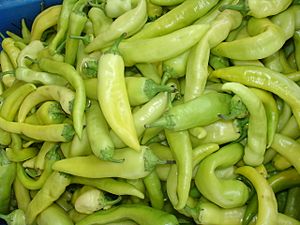Banana pepper facts for kids
Quick facts for kids Banana pepper |
|
|---|---|

Armenian banana peppers
|
|
| Species | Capsicum annuum |
| Heat | |
| Scoville scale | 0–500 SHU |
The banana pepper is a type of chili pepper known for its mild, tangy taste. You might also hear it called the yellow wax pepper or banana chili. These peppers are usually bright yellow. But they can turn green, red, or orange as they get older.
People often use banana peppers in many ways. They are great for pickling, stuffing, or eating fresh in different dishes. Banana peppers are a specific type of plant from the Capsicum annuum family. They are not very spicy at all. Their heat level is usually between 0 and 500 on the Scoville scale. This scale measures how hot peppers are. Like most peppers, the riper ones tend to be sweeter than younger ones.
Contents
Why is it Called a Banana Pepper?
When a banana pepper is fully grown, it's about 2 to 3 inches (5–8 cm) long. It has a curved shape and a yellowish color. This look is very similar to a banana, which is how it got its name!
Sometimes, people get banana peppers mixed up with other peppers like pepperoncini. It's easy to confuse them because they look a bit alike. If you find a banana pepper that is spicy, it's probably a hot type called a Hungarian wax pepper.
Growing Banana Peppers
Banana pepper plants need lots of sunshine to grow well. They are similar to other plants in the pepper family. You can start growing them from seeds or from small plant pieces called cuttings.
A full-grown banana pepper plant can reach 1 to 2 feet tall. They can grow in many different places, but they really love warm weather. Some popular types of banana peppers include 'Early Sweet Banana' and 'Sweet Hungarian'.
Healthy and Delicious Peppers
Banana peppers are mostly water, about 92%. They also have some carbohydrates. They are a fantastic source of vitamin C. Just 100 grams of raw banana peppers gives you all the vitamin C you need for the day! They also contain a good amount of Vitamin B6. These peppers are a healthy and tasty addition to your meals.
Ways to Enjoy Banana Peppers
Banana peppers are very versatile. This means they can be used in many different ways in the kitchen.
- Pickled Peppers: You can often find pickled banana peppers already sliced. They are a popular topping for pizzas, sandwiches, and Greek salads.
- Stuffed Peppers: Pickled or fresh banana peppers can be stuffed. They are often filled with tasty things like prosciutto (a type of ham) or different kinds of cheese. You might see these on appetizer platters called Antipasto bars.
- Warm Dishes: Stuffed banana peppers can also be served warm. They are often filled with Italian sausage and various cheeses for a hearty meal.
- Relishes and Salsas: If you chop or dice banana peppers, they add a nice sweetness to relishes and salsas. Other peppers can then add the heat.
- Pepper Jelly: Banana peppers can even be made into a jelly. They are sometimes mixed with other hot green peppers like jalapeños for a sweet and spicy spread.


